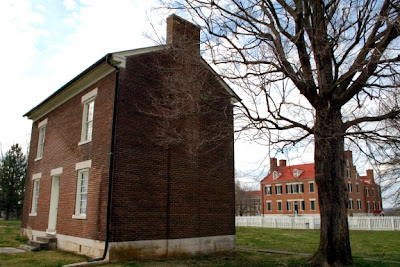Part 2 of our day at South Union Shaker Village . . .
Monument marking the location of the cemetery . . . resting place for over 400 people. Notice that there are no headstones. Also, note that this monument was only erected in 2011. And remember in our first entry, I stated I would explain why there was just the foundation that remains of the Meeting House? Lastly, I also had stated that there were over 200 structures at South Union and most of those were sound when the auction took place in 1922. What happened? A man named Oscar Bond happened . . .
From an article and radio interview at WKU Public Radio:
. . . the reason for the confusion can be traced back to the 1920’s, when a Louisville businessman named Oscar Bond purchased the land making up the South Union Shaker Village. According to Hines, Bond was less than interested in historic preservation.“He’s the one who took all the gravestones up and ground up all the limestone markers and used that lime on the farm,” says Hines. “And then there were a series of iron grave markers that had been put up during the 1870s—what they called “lollipop” markers, with a very distinctive shape that you find in several Shaker villages. It appeared that the new owner of the property plowed these under, because we’ve found buckets and buckets of pieces of those since that time.”
1846 Ministry Shop (from the brochure):
Each Shaker village was governed by an Elder and an Eldress, known as the Ministry. The Ministry Shop is where they, each with an assistant, lived and worked. The woman used the the front door and occupied the second floor and the men lived and worked downstairs, passing through the south entrance. The vivid paint colors used in the building are reproductions of the original surfaces.
View of the Ministry Shop from the south, with the Centre House in the background. I guess I should have posted a couple of photos of the very colorful interior, but I didn't. So, I guess you'll just have to visit to see it.
1835 Smoke and Milk House (again from the brochure): "Subsidiary to the Centre House kitchen, the Smoke and Milk House was where butter and cheese were made and where meat was preserved and stored. Innovative for its time, the building's architectural plan allowed for efficient use of space and an environment much cleaner than such buildings on regional farms."
1875 Grain Barn . . . it has a built-in scale in the floor. Dr. J and Dudeboy are just to the right of it. This is the only surviving barn at South Union.
1869 Shaker Tavern . . . located a couple of miles from what remains of the main village, Shaker Tavern was a railroad hotel operated by the Shakers. Today the Shaker Tavern operates as a bed and breakfast.
In the background and to the left is the 1817 Shaker Store. It is apparently to be restored when funding becomes available.













No comments:
Post a Comment